Page 490 of 648
4907-3. Do-it-yourself maintenance
AVENSIS_OM_OM20C20E_(EE)
Light bulbs
Check the wattage of the light bulb to be replaced. (→P. 615)
→ P. 4 4 5
■Front
You may replace the following bulbs by yourself. The difficulty
level of replacement varies depending on the bulb. As there is a
danger that components may be damaged, we recommend that
replacement is carried out by any authorized Toyota dealer or
repairer, or another duly qualified and equipped professional.
Preparing for light bulb replacement
Removing the engine compartment cover
Bulb locations
Headlights (halogen headlights)
Front fog light (if equipped)
Cornering/fog light (if equipped) Front turn signal light
Side turn signal light1
2
3
4
AVENSIS_OM_OM20C20E_(EE).book Page 490 Thursday, January 29,
2015 1:47 PM
Page 525 of 648
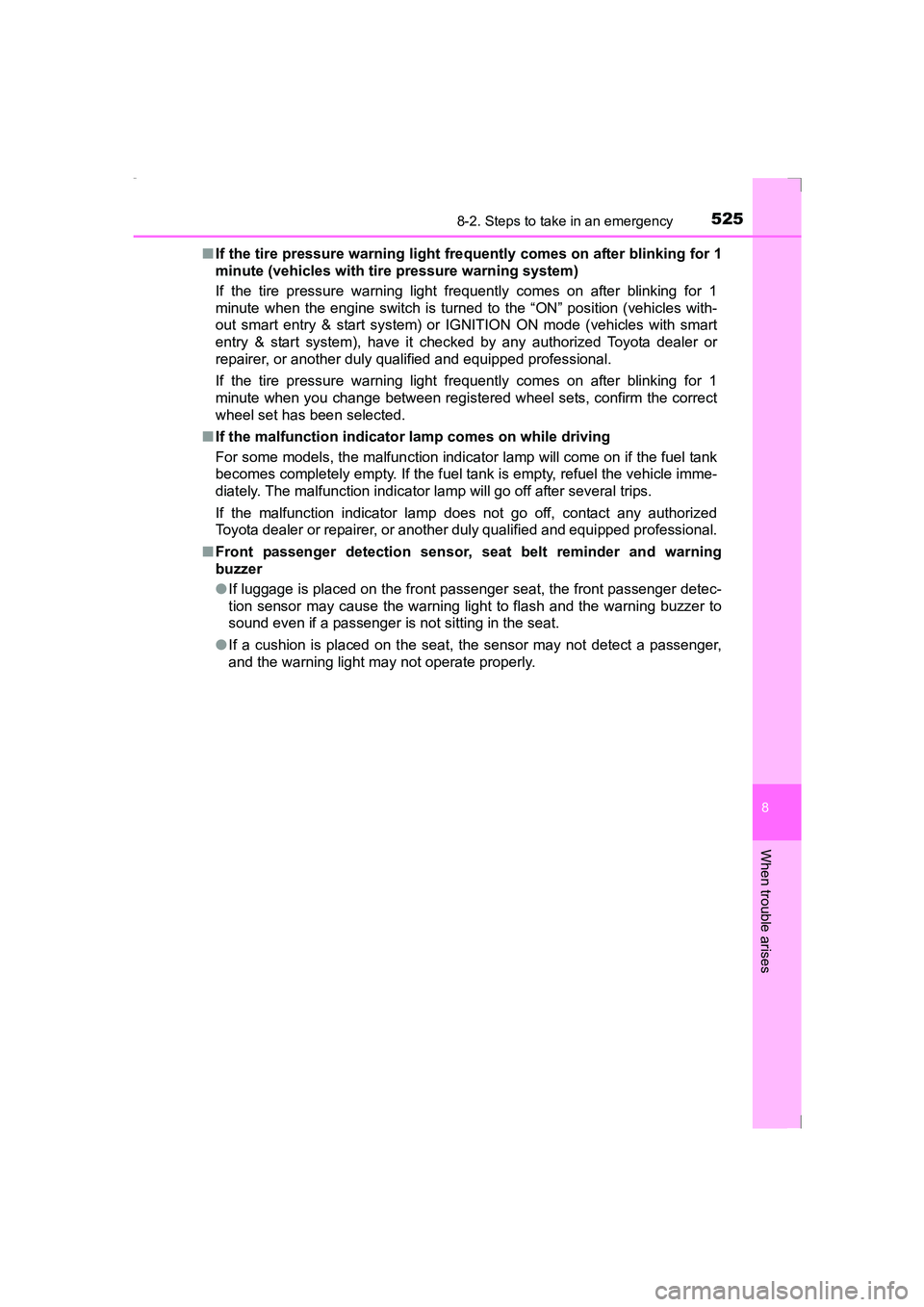
5258-2. Steps to take in an emergency
AVENSIS_OM_OM20C20E_(EE)
8
When trouble arises
■If the tire pressure warning light fre quently comes on after blinking for 1
minute (vehicles with tire pressure warning system)
If the tire pressure warning light frequently comes on after blinking for 1
minute when the engine switch is turned to the “ON” position (vehicles with-
out smart entry & start system) or IGNITION ON mode (vehicles with smart
entry & start system), have it checked by any authorized Toyota dealer or
repairer, or another duly qualified and equipped professional.
If the tire pressure warning light frequently comes on after blinking for 1
minute when you change between registered wheel sets, confirm the correct
wheel set has been selected.
■ If the malfunction indicator lamp comes on while driving
For some models, the malfunction indicator lamp will come on if the fuel tank
becomes completely empty. If the fuel tank is empty, refuel the vehicle imme-
diately. The malfunction indicator lamp will go off after several trips.
If the malfunction indicator lamp does not go off, contact any authorized
Toyota dealer or repairer, or another duly qualified and equipped professional.
■ Front passenger detection sensor, seat belt reminder and warning
buzzer
● If luggage is placed on the front passenger seat, the front passenger detec-
tion sensor may cause the warning light to flash and the warning buzzer to
sound even if a passenger is not sitting in the seat.
● If a cushion is placed on the seat, the sensor may not detect a passenger,
and the warning light may not operate properly.
AVENSIS_OM_OM20C20E_(EE).book Page 525 Thursday, January 29, 2015 1:47 PM
Page 533 of 648
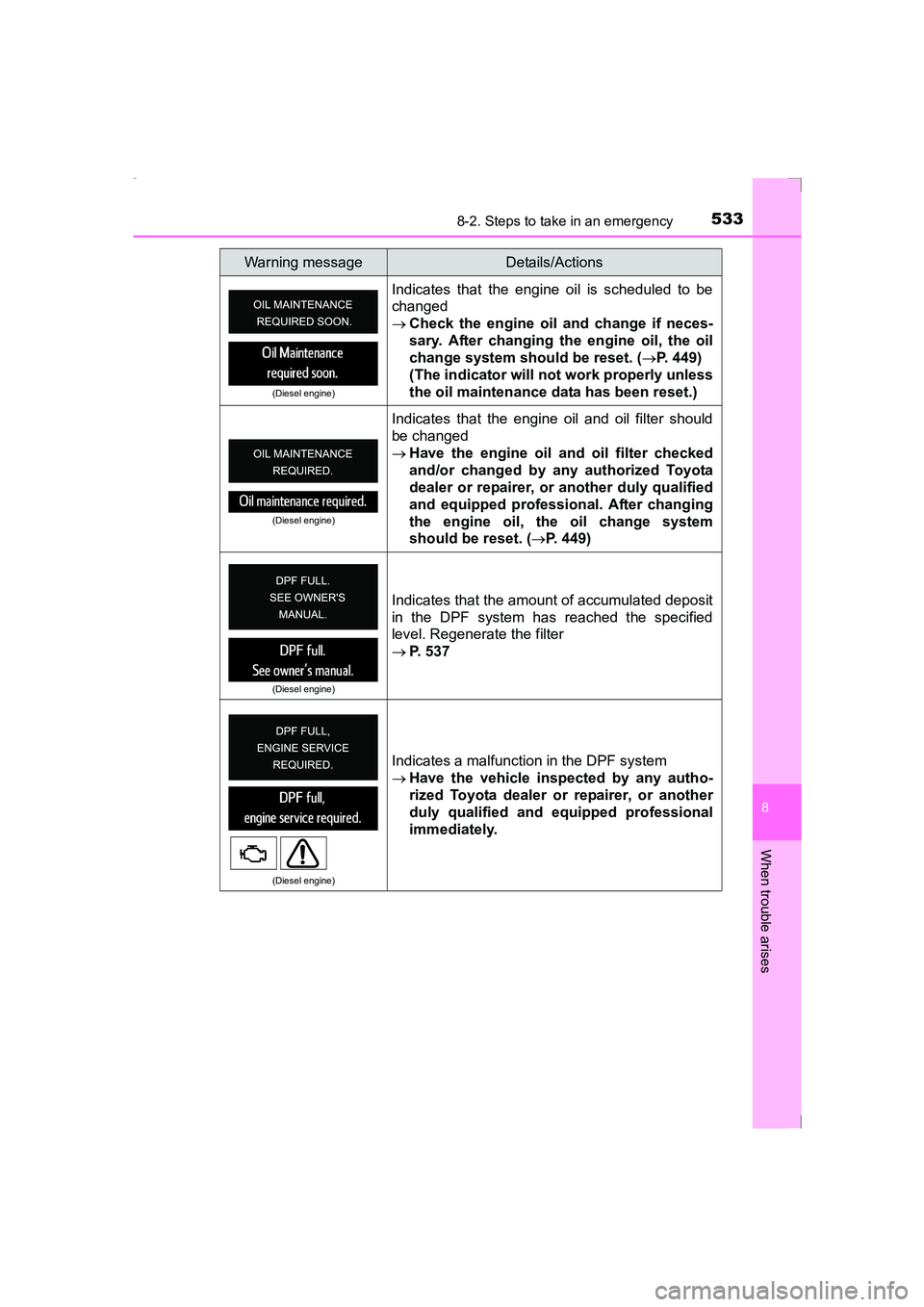
5338-2. Steps to take in an emergency
AVENSIS_OM_OM20C20E_(EE)
8
When trouble arises
(Diesel engine)
Indicates that the engine oil is scheduled to be
changed
→Check the engine oil and change if neces-
sary. After changing the engine oil, the oil
change system should be reset. ( →P. 449)
(The indicator will not work properly unless
the oil maintenance data has been reset.)
(Diesel engine)
Indicates that the engine oil and oil filter should
be changed
→ Have the engine oil and oil filter checked
and/or changed by any authorized Toyota
dealer or repairer, or another duly qualified
and equipped professional. After changing
the engine oil, the oil change system
should be reset. ( →P. 449)
(Diesel engine)
Indicates that the amount of accumulated deposit
in the DPF system has reached the specified
level. Regenerate the filter
→ P. 537
(Diesel engine)
Indicates a malfunction in the DPF system
→Have the vehicle inspected by any autho-
rized Toyota dealer or repairer, or another
duly qualified and equipped professional
immediately.
Warning messageDetails/Actions
AVENSIS_OM_OM20C20E_(EE).book Page 533 Thursday, January 29, 2015 1:47 PM
Page 547 of 648
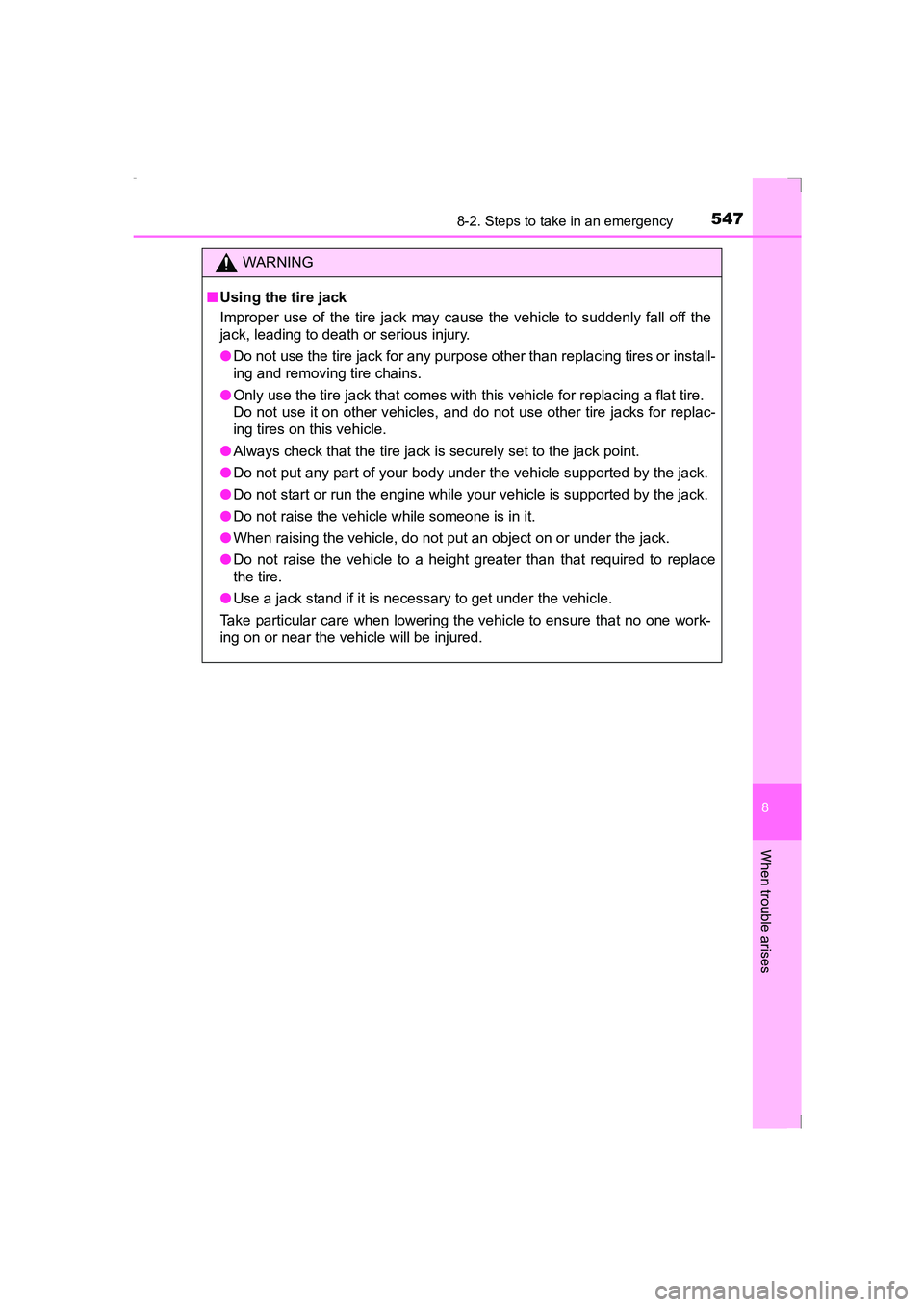
5478-2. Steps to take in an emergency
AVENSIS_OM_OM20C20E_(EE)
8
When trouble arises
WARNING
■ Using the tire jack
Improper use of the tire jack may cause the vehicle to suddenly fall off the
jack, leading to death or serious injury.
●Do not use the tire jack for any purpose other than replacing tires or install-
ing and removing tire chains.
● Only use the tire jack that comes with this vehicle for replacing a flat tire.
Do not use it on other vehicles, and do not use other tire jacks for replac-
ing tires on this vehicle.
● Always check that the tire jack is securely set to the jack point.
● Do not put any part of your body under the vehicle supported by the jack.
● Do not start or run the engine while your vehicle is supported by the jack.
● Do not raise the vehicle while someone is in it.
● When raising the vehicle, do not put an object on or under the jack.
● Do not raise the vehicle to a height greater than that required to replace
the tire.
● Use a jack stand if it is necessary to get under the vehicle.
Take particular care when lowering the vehicle to ensure that no one work-
ing on or near the vehicle will be injured.
AVENSIS_OM_OM20C20E_(EE).book Page 547 Thursday, January 29, 2015 1:47 PM
Page 566 of 648
5668-2. Steps to take in an emergency
AVENSIS_OM_OM20C20E_(EE)
Make sure that the compressor
switch is off.
Remove the power plug from
the compressor.
Connect the power plug to the
power outlet socket. (→P. 418)
Check the specified tire inflation pressure.
Tire inflation pressure is specified on the label as shown.
Start the vehicle’s engine.
9
10
11
12
�XLeft-hand drive vehicles�XRight-hand drive vehicles
13
AVENSIS_OM_OM20C20E_(EE).book Page 566 Thursday, January 29, 2015 1:47 PM
Page 578 of 648
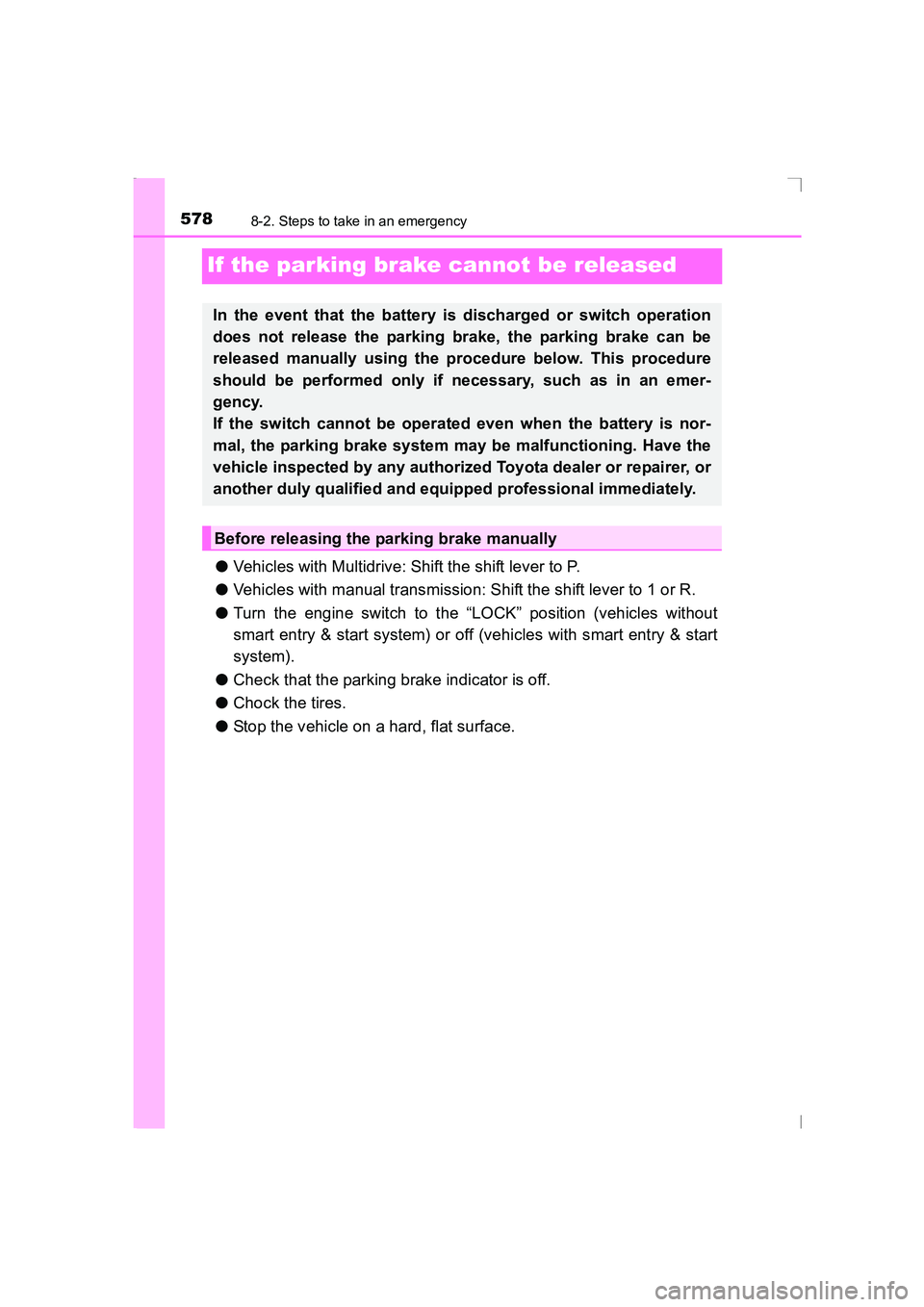
5788-2. Steps to take in an emergency
AVENSIS_OM_OM20C20E_(EE)
If the parking brake cannot be released
●Vehicles with Multidrive: Shift the shift lever to P.
● Vehicles with manual transmission: Shift the shift lever to 1 or R.
● Turn the engine switch to the “LOCK” position (vehicles without
smart entry & start system) or off (vehicles with smart entry & start
system).
● Check that the parking brake indicator is off.
● Chock the tires.
● Stop the vehicle on a hard, flat surface.
In the event that the battery is discharged or switch operation
does not release the parking brake, the parking brake can be
released manually using the procedure below. This procedure
should be performed only if necessary, such as in an emer-
gency.
If the switch cannot be operated even when the battery is nor-
mal, the parking brake system may be malfunctioning. Have the
vehicle inspected by any authorized Toyota dealer or repairer, or
another duly qualified and equipped professional immediately.
Before releasing the parking brake manually
AVENSIS_OM_OM20C20E_(EE).book Page 578 Thursday, January 29, 2015 1:47 PM
Page 581 of 648
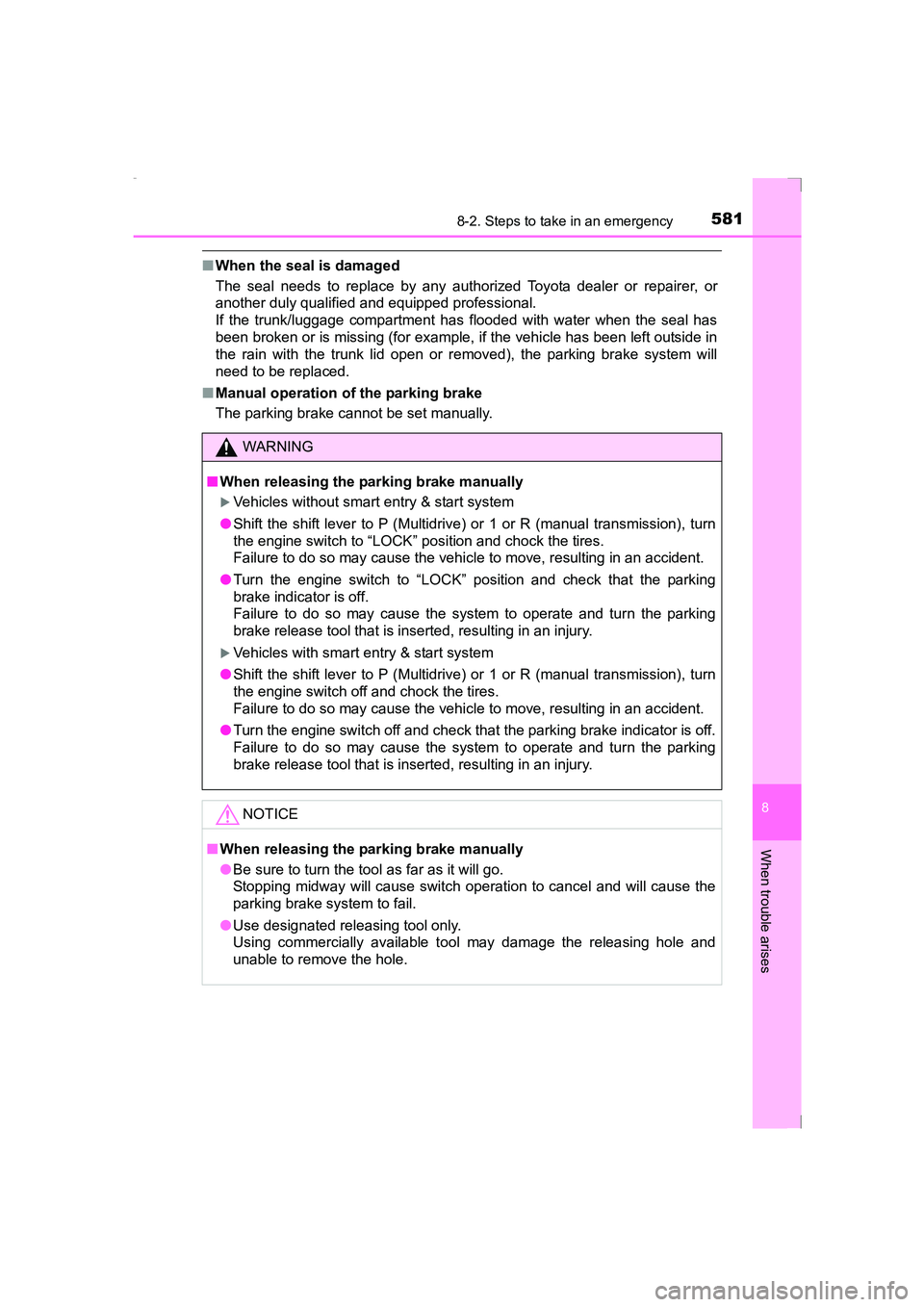
5818-2. Steps to take in an emergency
AVENSIS_OM_OM20C20E_(EE)
8
When trouble arises
■When the seal is damaged
The seal needs to replace by any aut horized Toyota dealer or repairer, or
another duly qualified and equipped professional.
If the trunk/luggage compartment has flooded with water when the seal has
been broken or is missing (for example, if the vehicle has been left outside in
the rain with the trunk lid open or removed), the parking brake system will
need to be replaced.
■ Manual operation of the parking brake
The parking brake cannot be set manually.
WARNING
■ When releasing the parking brake manually
�XVehicles without smart entry & start system
● Shift the shift lever to P (Multidrive) or 1 or R (manual transmission), turn
the engine switch to “LOCK” position and chock the tires.
Failure to do so may cause the vehicle to move, resulting in an accident.
● Turn the engine switch to “LOCK” position and check that the parking
brake indicator is off.
Failure to do so may cause the system to operate and turn the parking
brake release tool that is inserted, resulting in an injury.
�XVehicles with smart entry & start system
● Shift the shift lever to P (Multidrive) or 1 or R (manual transmission), turn
the engine switch off and chock the tires.
Failure to do so may cause the vehicle to move, resulting in an accident.
● Turn the engine switch off and check that the parking brake indicator is off.
Failure to do so may cause the system to operate and turn the parking
brake release tool that is inserted, resulting in an injury.
NOTICE
■ When releasing the parking brake manually
●Be sure to turn the tool as far as it will go.
Stopping midway will cause switch operation to cancel and will cause the
parking brake system to fail.
● Use designated releasing tool only.
Using commercially available tool may damage the releasing hole and
unable to remove the hole.
AVENSIS_OM_OM20C20E_(EE).book Page 581 Thursday, January 29, 2015 1:47 PM
Page 591 of 648
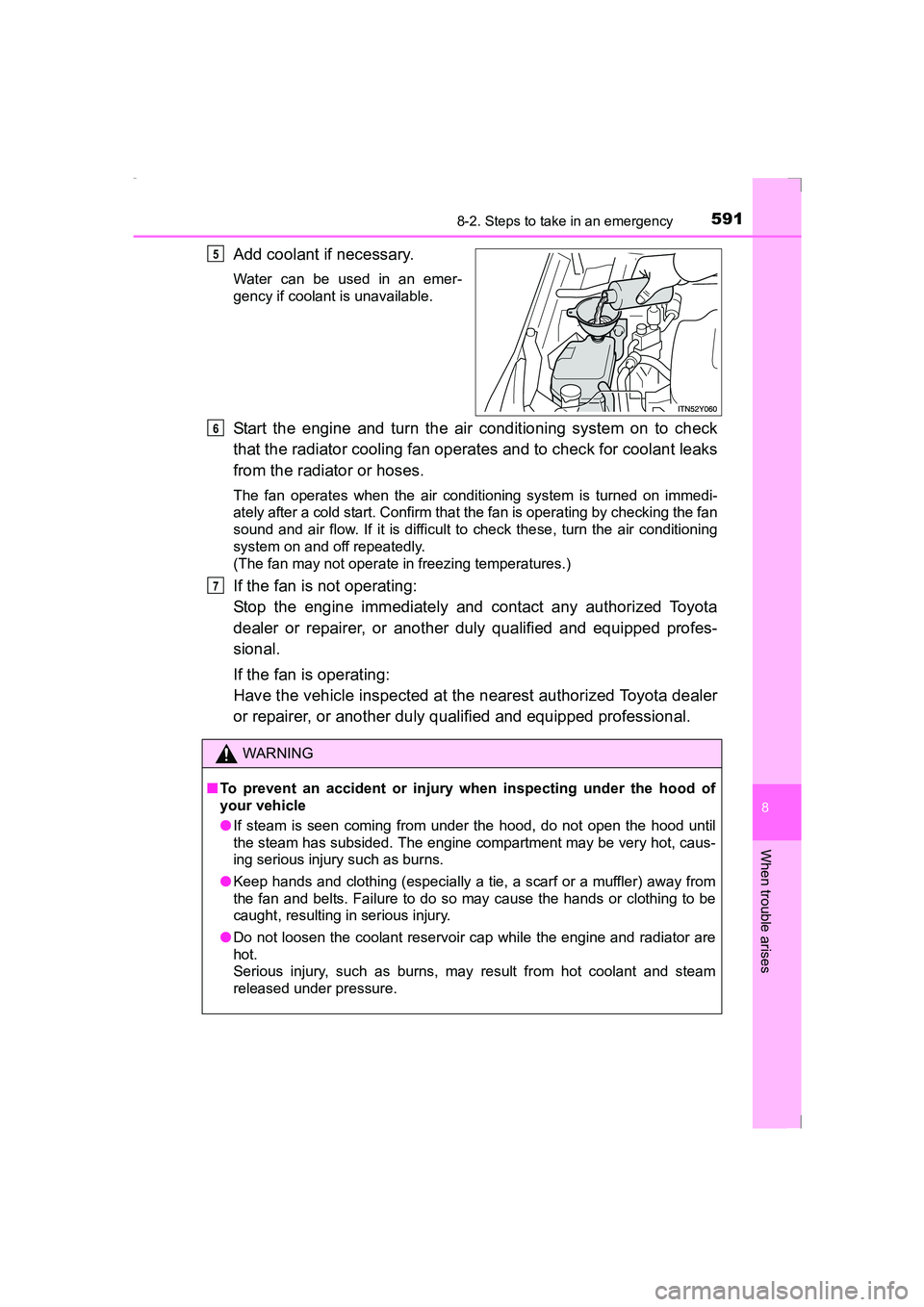
5918-2. Steps to take in an emergency
AVENSIS_OM_OM20C20E_(EE)
8
When trouble arises
Add coolant if necessary.
Water can be used in an emer-
gency if coolant is unavailable.
Start the engine and turn the air conditioning system on to check
that the radiator cooling fan operates and to check for coolant leaks
from the radiator or hoses.
The fan operates when the air conditioning system is turned on immedi-
ately after a cold start. Confirm that the fan is operating by checking the fan
sound and air flow. If it is difficult to check these, turn the air conditioning
system on and off repeatedly.
(The fan may not operate in freezing temperatures.)
If the fan is not operating:
Stop the engine immediately and contact any authorized Toyota
dealer or repairer, or another duly qualified and equipped profes-
sional.
If the fan is operating:
Have the vehicle inspected at the nearest authorized Toyota dealer
or repairer, or another duly qualified and equipped professional.
5
WARNING
■ To prevent an accident or injury when inspecting under the hood of
your vehicle
●If steam is seen coming from under the hood, do not open the hood until
the steam has subsided. The engine compartment may be very hot, caus-
ing serious injury such as burns.
● Keep hands and clothing (especially a tie, a scarf or a muffler) away from
the fan and belts. Failure to do so may cause the hands or clothing to be
caught, resulting in serious injury.
● Do not loosen the coolant reservoir cap while the engine and radiator are
hot.
Serious injury, such as burns, may result from hot coolant and steam
released under pressure.
6
7
AVENSIS_OM_OM20C20E_(EE).book Page 591 Thursday, January 29, 2015 1:47 PM